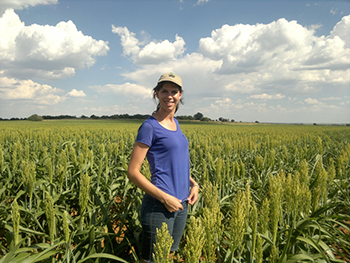Latest News Archive
Please select Category, Year, and then Month to display items
20 June 2023
|
Story Melissa Kilian
|
Photo Supplied
 Melissa Kilian is a Lecturer in the Department of Occupational Therapy.
Melissa Kilian is a Lecturer in the Department of Occupational Therapy.
The University of the Free State (UFS) is celebrating Youth Month by showcasing the positive influence of the institution on career development. As part of this initiative, we are sharing the stories of UFS alumni who are now working at the university.
Melissa Kilian, Lecturer in the Department of Occupational Therapy, shares her UFS journey:
Q: Year of graduation from the UFS:
A: 2011 and 2021.
Q: Qualification obtained from the UFS:
A: Baccalaureus and Master of Occupational Therapy.
Q: Date of joining the UFS as a staff member:
A: 1 June 2022 (employed for one year this month).
Q: Initial job title and current job title:
A: Lecturer in Occupational Therapy.
Q: How did the UFS prepare you for the professional world?
A: The UFS provided me with excellent clinical exposure to the diverse profession of occupational therapy. Additionally, the occupational therapy undergraduate course provided many opportunities for promoting self-awareness and self-development and entering the workforce as a graduate willing to explore the dimensions of the profession and what my unique contribution can be.
Q: What are your thoughts on transitioning from a UFS alumnus to a staff member?
A: Since being employed with the UFS, I have a deeper acknowledgement and appreciation for lecturers, as well as a multi-layered understanding of the importance of curriculum development and how this translates into students becoming competent graduates.
Q: Any additional comments about your experience?
A: It’s been quite an experience ...!
Researcher works on finding practical solutions to plant diseases for farmers
2017-10-03

Lisa Ann Rothman, researcher in the Department of
Plant Sciences.
Photo: Supplied
Plant disease epidemics have wreaked havoc for many centuries. Notable examples are the devastating Great Famine in Ireland and the Witches of Salem.
Plant diseases form, due to a reaction to suitable environments, when a susceptible host and viable disease causal organism are present. If the interactions between these three factors are monitored over space and time the outcome has the ability to form a “simplification of reality”. This is more formally known as a plant disease model. Lisa Ann Rothman, a researcher in the Department of Plant Sciences at the University of the Free State (UFS) participated in the Three Minute Thesis competition in which she presented on Using mathematical models to predict plant disease.
Forecast models provide promise fighting plant diseases
The aim of Lisa’s study is to identify weather and other driving variables that interact with critical host growth stages and pathogens to favour disease incidence and severity, for future development of risk forecasting models. Lisa used the disease, sorghum grain mold, caused by colonisation of Fusarium graminearum, and concomitant mycotoxin production to illustrate the modelling process.
She said: “Internationally, forecasting models for many plant diseases exist and are applied commercially for important agricultural crops. The application of these models in a South African context has been limited, but provides promise for effective disease intervention technologies.
Contributing to the betterment of society
“My BSc Agric (Plant Pathology) undergraduate degree was completed in combination with Agrometeorology, agricultural weather science. I knew that I wanted to combine my love for weather science with my primary interest, Plant Pathology.
“My research is built on the statement of Lord Kelvin: ‘To measure is to know and if you cannot measure it, you cannot improve it’. Measuring the changes in plant disease epidemics allows for these models to be developed and ultimately provide practical solutions for our farmers. Plant disease prediction models have the potential ability to reduce the risk for famers, allowing the timing of fungicide applications to be optimised, thus protecting their yields and ultimately their livelihoods. I am continuing my studies in agriculture in the hope of contributing to the betterment of society.”